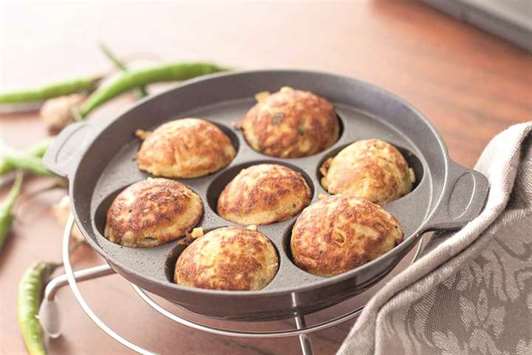Being from northern part of India, I always liked and was inclined towards the south Indian dishes like Dosa and Idli as a child but never got to travel to southern India. As I grew, my love for south Indian dishes also increased and especially when I decided to be a chef. My outlook towards south Indian cuisine broadened and I started researching more about the cuisine in the early days of my culinary career. That’s when I came across a dish called Paniyaram and that instantly became my third favourite after Dosa and Idli. Also during my beautiful days in Qatar, where there is a large south Indian population, these were frequent additions to my restaurant menu and were served on special occasion in buffet too.
South India mainly comprises of four states — Tamil Nadu, Kerala, Karnataka and Andhra Pradesh. Rice is a staple in these states thus a lot of dishes revolve around rice. Also, these states have abundance of spice production which are also freely incorporated in their respective cuisines. Chettinad cuisine uses a lot of spices and I would say is the most spicy cuisine in Indian subcontinent. The dish comes from Tamil Nadu, a state known for its delicious signature dishes that originated in the region. It is made with a specific mold called paniyaram pan which is available in almost all supermarkets in India, Middle Eastern and South-East Asia regions due to the large south Indian population in these foreign lands. People, who like their Dosa and Idli would love this dish too as the batter used to make them is very similar. The batter recipes mostly include rice and lentil fermented batter but I prefer to add chopped onions, carrots, chili, curry leaves to the batter to spice it up. It is mostly served as a breakfast dish with coconut chutney or spicy tomato chutney.
A special cooking pan or tray with several round compartments like a mini muffin tray is the traditional cookware used for making Paniyaram. The pan is made with cast iron and is very durable. The benefit of cooking in cast iron utensils is that the iron imparts a great taste to the dishes cooked in it and retains heat well and gives a nice golden-brown crust to Paniyaram. Non-stick paniyaram pans are also available but I prefer the cast iron simply for their long life and great taste they impart to dish cooked in them. At first a batter is made from combining rice and washed black lentil, known as ‘urad dal’. Fenugreek seeds and salt are used to season the batter. The batter is made by soaking the ingredients preferably overnight. Then grinding it to a paste and letting it ferment at room temperature. The grinder used to make the batter is made from a special stone which grounds the rice and lentils to desired thickness. Now a day, you get a ready-made batter in almost all supermarkets and thus simplifying the whole process of soaking, grinding and fermentation. You just add some additives to the batter if you wish and then cook them in paniyaram pan. Additional ingredients like carrots, ginger, green chili, black pepper, onions, curry leaves, mustard seeds can also be added to the batter to make it more flavourful. After mixing the batter is poured into the pan’s compartment and placed in an open or cooked on flame. After a while the buns must be flipped in their own shell to cook and crust them from other side too. A perfect paniyaram should have a golden-brown crust all around it. The paniyaram are served with coconut chutney but you can replace that with your choice of sauce. When you add additional flavourings to the batter you can even consume it without any sauce along. These are one of the great lunch box ideas for kids as they are simple, fresh and kids like eating these small round buns.
Chettinad Paniyaram
Ingredients
Idli Batter 3 cups
Onion, chopped 1 no.
Green chili, chopped 2-3 no.
Curry leaves 2-3 sprigs
Eggs 2 no.
Coriander leaves, chopped 2 tbsp.
Mustard seeds ½ tsp
Asafetida ½ tsp
Turmeric powder 1 tsp
Cumin powder 2 tsp
Red chili powder 2 tsp
Black pepper powder ½ tsp
Grated coconut ½ cup
Salt to taste
Cooking oil to cook
Method
In a heavy bottom pan heat oil over medium heat, add mustard seeds and let it splutter for few seconds
Add onion, ginger, green chilies, asafetida and curry leaves and sauté for few seconds till the onion is translucent
Add turmeric powder, chili powder, cumin, red chili powder, black pepper powder and grated coconut and stir for few minutes
Remove from flame and keep aside
In a separate bowl add egg to the batter, add the prepared onion mixture and chopped cilantro leaves and adjust the seasoning
Combine well to a homogeneous mixture, keep aside
Heat the paniyaram pan over medium heat and add ½ tsp oil in each cup
Drop the prepared batter using a table soon into each cup
Cover with the lid and cook over medium flame for 4-5 minutes, flip the cakes using a fork in their own cup and cook again covered for 5 minutes
Add more oil if required, you can also use a pan spray to coat the pan and prevent them sticking to the pan
Serve hot with coconut chutney or your choice of sauce.
* Chef Tarun Kapoor, Culinary Mastermind, USA. He may be contacted at [email protected]

SPICY: Chettinad Paniyaram is served hot with coconut chutney. Photo by the author
